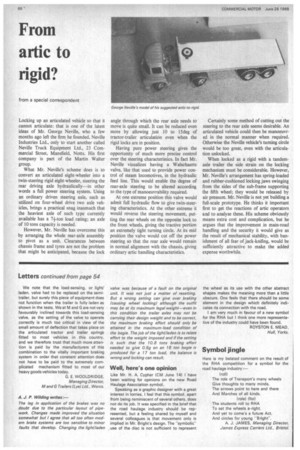From artic to rigid?
Page 68

If you've noticed an error in this article please click here to report it so we can fix it.
from a special correspondent
Locking up an articulated vehicle so that it cannot articulate: that is one of the latest ideas of Mr. George Neville, who a few months ago left the firm he founded, Neville Industries Ltd., only to start another called Neville Truck Equipment Ltd., 23 Commercial Street, Mansfield, Notts. His first company is part of the Martin Walter group.
What Mr. Neville's scheme does is to convert an articulated eight-wheeler into a twin-steering rigid eight-wheeler, steering the rear driving axle hydraulically—in other words a full power steering system. Using an ordinary driven steering axle, such as utilized on four-wheel drive two axle vehicles, brings a practical snag inasmuch that the heaviest axle of such type currently available has a 7fton load rating; an axle of 10 tons capacity is needed.
However, Mr. Neville has overcome this by arranging the whole rear-axle assembly to pivot as a unit. Clearances between chassis frame and tyres are not the problem that might be anticipated, because the lock angle through which the rear axle needs to move is quite small. It can be reduced even more by allowing just 10 to 15deg of tractor-trailer articulation even when the rigid locks are in position.
Having pure power steering gives the opportunity of much more precise control over the steering characteristics. In fact Mr. Neville visualizes having a Walschaerts valve, like that used to provide power control of steam locomotives, in the hydraulic feed line. This would enable the degree of rear-axle steering to be altered according to the type of manoeuvrability required.
At one extreme position this valve would admit full hydraulic flow to give twin-steering characteristics. At the other extreme it would reverse the steering movement, putting the rear wheels on the opposite lock to the front wheels, giving the tractive portion an extremely tight turning circle. At its mid position the valve would cut off the power steering so that the rear axle would remain in normal alignment with the chassis, giving ordinary artic handling characteristics. Certainly some method of cutting out the steering to the rear axle seems desirable. An articulated vehicle could then be manoeuvred in the normal manner when required. Otherwise the Neville vehicle's turning circle would be too great, even with the articulation unlocked.
When locked as a rigid with a tandemaxle trailer the side strain on the locking mechanism must be considerable. However, Mr. Neville's arrangement has spring-loaded and rubber-cushioned locking jaws swinging from the sides of the sub-frame supporting the fifth wheel; they would be released by air pressure. Mr. Neville is not yet building a full-scale prototype. He thinks it important first to get the reactions of artic operators and to analyse these. His scheme obviously means extra cost and complication, but he argues that the improvement in main-road handling and the security it would give as the result of mechanical stability, with banishment of all fear of jack-knifing, would be sufficiently attractive to make the added expense worthwhile.
























































































































